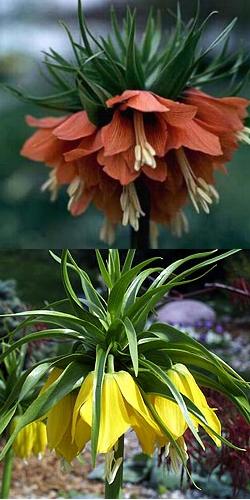October
2001
Did you know that
Fritillaria Imperialis (Crown imperial) is native to western Himalayas?
 |
|
Fritillaria
imperialis.
Orange red (Aurora)-lemon yellow (Lutea)
|
Fritillaria imperialis (Crown
imperial)
The genus, Fritillaria consists of almost 100
species and they share their botanical name fritillus
with a butterfly. All of these
are found in the northern hemisphere, with the main habitats being the
areas around the Mediterranean. Only a limited number are being
cultivated, but interest in this genus is very much on the rise.
Fritillaria imperialis (Linn.), is by far the most
well-known species. It is also one of the
earliest plants to be cultivated. Clusius introduced this majestic
plant to the Netherlands as early as the 16th century. Illustrations
of it date back to 1610! The Crown Imperial Lily of Persia, is found in such locations as
Turkey, Iran, Afghanistan, Pakistan, Kashmir and western Himalayas. It's said to be there cultivated as a food
plant, its bulb
possessing poisonous properties when raw, but being wholesome when
cooked.
There are two kinds of this handsome
plant, associated with the
earliest type of English gardens. They bear a circle of pendulous
flowers - one blooms pure lemon yellow (Lutea), the other deep orange red
(Aurora)-
and have a crown of foliage above them. The same name is given to this
Lily in all European languages.
Many
fritillaries have a strong scent to them which some people find
unpleasant. Fritillaria imperialis (whose bulb, by the way, smells exactly like
elephants, or, according to other noses than mine, like foxes); it can be smelled in the spring even when buried two feet
deep. Even honey from the
flowers is said to be emetic. Imperialine was isolated by Fragner in 1888, on extracting
the bulbs with chloroform. This alkaloid and its salts are intensely
bitter and are heart poisons. No medicinal use is made of the plant.
The stately Fritillaria imperialis, or crown
imperial, with its crown-like tufts of foliage and nodding, nectar-laden
orange to yellow flowers, is known in Farsi (the language of Iraq) as
the "Tears of Mary." Christian tradition recalls that of all
the flowers, only the proud crown imperial refused to bow its head
during the Crucifixion. As a consequence, it has "bowed" and
"wept" ever since.
F. imperialis can reach up
to 1.5m (5ft) tall. Plant these large, unpleasantly scented bulbs as early in the
season as possible, and immediately after acquiring them. This is
necessary because the roots will start developing inside the packaging,
and this can result in damage during planting. The soil must drain
quickly and thoroughly; heavy soil will definitely need the addition
of extra sand. Specimens that receive what they need often continue to
flower year after year in the same location, especially in climatic
zones 4 - 6. Sometimes, however, a stem emerges but fails to bloom. In
that case, plant new bulbs in another location, preferably among
ground cover plants. The flowers have a distinctive musk-like odor and
contain large drops of nectar.
Source:
http://www.bulb.com/springguide98/fritillaria.asp
http://www.botanical.com/botanical/mgmh/l/lilcro22.html
http://www.bbg.org/gar2/topics/plants/2001sp_fritillarias.html
|
